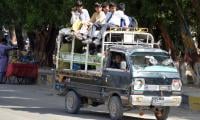LAHORE
Kashif was suspecting dengue fever and was taken to a private health facility by his family for treatment. The next day, while he was still in the hospital, a district government team visited his house and carried out indoor residual spray (IRS) despite the fact neither he nor any of his family member asked for the same.
As Kashif’s blood tests confirmed that he had dengue fever the team also carried out IRS in 12 houses on each of the four sides of his residence. Not only this, the activity was carried out at his workplace too! To the utter surprise of his family, the visiting team also showed platelets counts of the patient (of different time) on an Android handset. This happened in the Nishtar Town area of Lahore recently.
One wonders how did this happen? The simple answer is technology. Punjab Information Technology Board (PITB) developed this technology based health system and now this is effectively working across Punjab.
Under this anti-dengue initiative, four different, but linked, systems operate, including Dengue Activity Tracking System, Patient Reporting System, Health Complaint Management System and Vector Surveillance System while through a consolidated online dashboard everyone in the field is connected while it also allows officials, including the chief minister to track the progress instantly.
Who can forgot dengue outbreak in Lahore and adjacent areas in 2011. The epidemic had claimed 365 lives while there were over 21,000 confirmed dengue cases mostly in the provincial metropolis. This was the time when the PITB was tasked by the government to come up with some sort of smart solution and we know the following years the situation had significantly improved.
“The details about Kashif were inserted in the Patient Reporting System by the hospital and through the PITB developed dashboard the same were instantly accessible to everyone on the system”, said Salman Shabbir, programme officer at the PITB, explaining as to how the Nishtar Town team was alerted to carry out IRS. He added the IRS was part of the SOPs the district government teams strictly follow.
According to him, all hospitals, public and private, have been given access to the Patient Reporting System so that real-time information about suspected, probable or confirmed dengue patients are shared with those in the field, including teams from the Dengue Activity Tracking System and Vector Surveillance System.
The field staff uses Android application developed by the PITB to track the location of the confirmed dengue cases and the mosquito larvae and each case is geo-tagged with time and shared among all the stakeholders on the dashboard for prompt action.
“Over 13 million dengue containment, treatment and prevention activities have been logged in our system using smartphones. Such massive adoption of technology for a complex disease surveillance system is unprecedented anywhere in the world,” said PITB Chairman Dr Umar Saif.
The PITB developed dengue monitoring system not just tracks dengue patients and mosquito larvae as together with analysis of data generated through health helpline (0800-99000) the system can predict where dengue outbreaks are now starting and this is not just limited to Lahore. The data analysis process enables the government where it should prioritise its preventive activities.
For example, this season’s data shows that federal capital Islamabad has serious problem vis-à-vis dengue as most of the cases have been reported from there followed by Rawalpindi and Lahore.
In Lahore, DHA with most dengue positive cases reported so far has become the government’s priority this season for its anti-dengue activities.
In this still, Punjab Chief Secretary Zahid Akhtar Zaman chairs a meeting on April 19, 2024. — Facebook/Chief...
In this still, Minister for Social Welfare and Baitul Maal Sohail Shaukat Butt places Ali Hamza on a wheelchair on...
A general view of the Lahore University of Management Sciences . — LUMS Website/FileLAHORE:The Syed Ahsan Ali and...
Punjab University building in Lahore. — Facebook/Punjab University/File LAHORE: The Executive Council of the...
An undated picture of Pakistani female athletes running on a track. — Athletics Federation of Pakistan...
The Punjab Assembly building in Lahore. — Geo.tv/ fileLAHORE: The Punjab Assembly has commenced its pre-budget...







